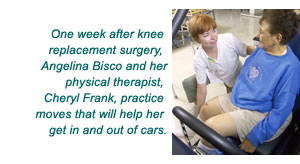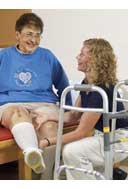Orthopaedic patients “GO CAMPING”
for a new lease on life.
Easton Hospital’s new JointWorks! program takes a creative approach to knee and hip replacement surgery. Instead of facing orthopaedic surgery and recovery alone, small groups of patients go through the procedure together. F rom their pre-op education class through their last outpatient physical therapy sessions, they share concerns and support—and even manage a to laugh along the way.
The “campers” check into private rooms in a dedicated orthopaedic area of the Hospital for their four-day stay. “Our patients appreciate the atmosphere of wellness,” says Fern Dougherty, Director of the program,“After all, they’re not sick.”With that in mind, patients are encouraged to bring and wear loose comfortable clothing instead of hospital gowns.

Special touches like a golf putting green in the Physical Therapy Department add to the summer camp atmosphere and provide some incentive for movement. Amenities like the services of a professional beautician keep morale high, and a gala luncheon on day three has campers expressing surprise at how far they’ve come in such a short time.
Surgical Relief
Hundreds of thousands of people undergo hip or knee replacement surgery each year and the success rates are very high—98% and 96% respectively. Most patients are able to regain complete use of the limb and resume all their normal activities. It’s an operation that can provide a whole new lease on life for joint pain suffere rs. Surgical replacement of worn out hips and knees has been done in the United States since the 1960s. In both operations, the painful parts of the joint are completely replaced with metal and plastic prostheses (artificial parts). The new surfaces fit together with much less friction and less stress to the joint itself.
rs. Surgical replacement of worn out hips and knees has been done in the United States since the 1960s. In both operations, the painful parts of the joint are completely replaced with metal and plastic prostheses (artificial parts). The new surfaces fit together with much less friction and less stress to the joint itself.
Patients in the JointWorks! program are up and sitting in their recliners the very same day of their surgeries. Group therapy sessions begin right away, and, with the help of nurses and coaches (usually spouses or friends), progress is rapid.
Up, Up, and Away
Of course, nobody is literally skipping after four days, but to many it feels that way.“There’s a great feeling of relief that the surgery’s over and patients can see that they’re better already,” says Fern.
For most it will be a good six weeks until they are back up to speed. Recuperating knee and hip replacement patients will go home with an exercise plan to strengthen healing ligaments and increase flexibility of the new joint. They will need to be especially careful of falling, stretching, or lifting for a while, and they will probably never ski again.
But giving up singles tennis or long-distance running for pain-free movement doesn’t seem like much of a sacrifice for most JointWorks participants.“Many of our patients tell me their biggest regret is that they waited so long to have it done,” Fern comments. “And that makes us feel very good.”